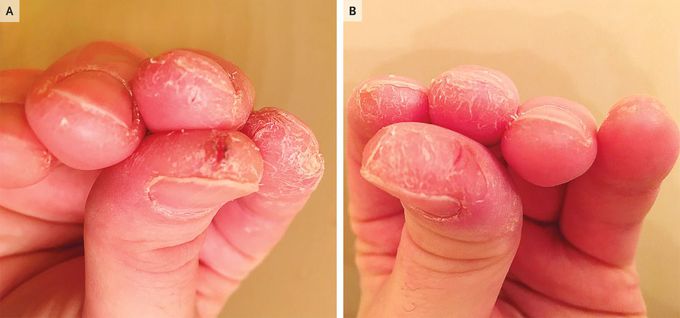


Mechanic’s Hands
A 37-year-old man presented to the outpatient rheumatology clinic with a 14-month history of painful, thickened, and cracked skin on his fingertips. He reported having intermittent low-grade fevers as well as having difficulty rising from a chair and raising his arms above his head. Examination was notable for weakness of the proximal muscles of the hip and shoulder regions. Thickened, hyperkeratotic, scaly, and fissured skin was visible on the tips and sides of the fingers and thumbs of both the right hand (Panel A) and the left hand (Panel B), a finding referred to as “mechanic’s hands.” Laboratory testing showed that the creatine kinase level was above 20,000 U per liter (reference range, 51 to 298). Tests for antinuclear antibody and rheumatoid factor were negative, but tests for anti–Jo-1 (anti–histidyl–transfer RNA synthetase) and anti-SSA (Ro-52) antibodies were positive. High-resolution computed tomography of the lungs revealed lower-lobe–predominant peripheral ground-glass opacities, subpleural reticulation, and traction bronchiectasis, findings that are characteristic of interstitial lung disease. A diagnosis of antisynthetase syndrome (a type of idiopathic inflammatory myopathy) was made. After 1 month of treatment with oral prednisone (60 mg daily) and azathioprine (150 mg daily), his “mechanic’s hands” resolved and the myositis and interstitial lung disease abated. After the glucocorticoid dose was tapered, treatment with intravenous rituximab every 6 months was initiated, and he has since remained symptom-free.

